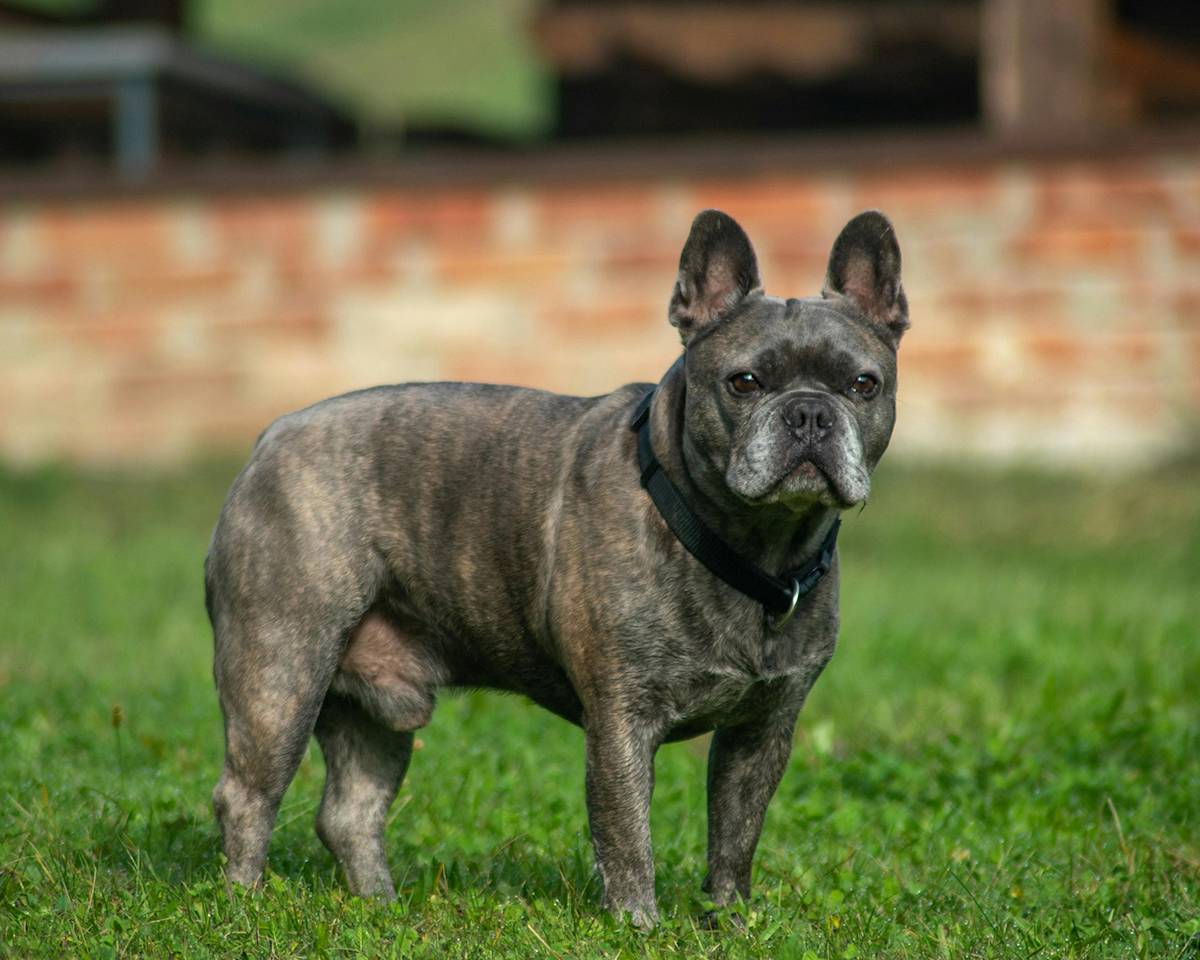Could This Free Tool Help Save America’s Favourite Dog Breed?
New online tool tackles French Bulldog breeding issues

Share Article
French Bulldogs have been topping popularity charts for years now – they’re America’s number one breed for the third year running, with nearly 75,000 registered in 2024, and they’re regularly sitting at number two in the UK. The demand makes sense on paper: they’re small, adaptable to living in flats and undeniably (and adorably) photogenic. But there’s a cruel catch that many prospective pet parents aren’t necessarily aware of, and often don’t learn about until they’re already emotionally (and financially) invested.
A significant number of these dogs are prone to serious health issues caused by extreme breeding practices. They have difficulty breathing properly. They overheat in mild weather. Their facial folds need daily cleaning to prevent painful infections. And for many pet parents, the reality of caring for a dog with extreme health issues comes as a bit of a shock – along with the sky-high vet bills and emotional toll.
Now, a groundbreaking initiative launched this week could mark a turning point for canine breeding welfare across the UK. On 18 November, the All-Party Parliamentary Group for Animal Welfare (APGAW) unveiled the Innate Health Assessment, a free tool that puts the power to identify harmful breeding practices directly into the hands of dog lovers, breeders and prospective puppy buyers.
The Innate Health Assessment (IHA)opens in new tab is an online tool designed to help prospective dog parents and breeders identify whether a dog has the physical characteristics needed for a healthy life. And, crucially, you don’t need any specialist equipment or veterinary training to use it.
The initiative has already garnered support from across the veterinary and animal welfare sector. Major organisations including the British Veterinary Association (BVA), the Royal Veterinary College (RVC), Dogs Trust, Battersea, Blue Cross, RSPCA, PDSA and The Kennel Club have all endorsed the tool.
Officials are calling the IHA a potential “breeding revolution”. If you’re considering getting a puppy, the IHA tool offers a way to check whether the parents have physical traits that could lead to health problems down the line. By avoiding puppies bred from dogs that don’t pass the assessment, prospective pet parents can help shift demand towards healthier breeding practices – and potentially save themselves from heartbreak and hefty veterinary bills.
What is the Innate Health Assessment?
Let’s start with the very basics. The term ‘innate health’ refers to the ability of an animal to perform all the natural functions and behaviours that are normally expected for that species. For example, a dog with good innate health should be able to carry out all the typical activities necessary for their wellbeing within the anatomical, physiological and behavioural norms for being, well... a dog.
The ‘Innate Health Concept’ was developed by Professor Dan O’Neill at the Royal Veterinary College, and this forms the basis for the new Innate Health Assessment. Working alongside Professor O’Neill, the All-Party Parliamentary Group for Animal Welfare (APGAW)opens in new tab developed the IHA to put dog health checks directly into the hands of breeders, prospective puppy buyers and even licensing officers.
The assessment evaluates dogs across 10 key health criteria, focusing on physical traits that, when bred to extremes, can cause serious welfare issues. Dogs need to pass at least eight of the 10 criteria to be considered suitable for breeding or, for prospective pet parents, to be a healthy choice.
What makes this tool so different to what currently exists is its accessibility. “We are putting the power into the hands of the general public to end the century of suffering caused to dogs by irresponsible extreme conformation breeding practices,” says Vanessa Barnes, legal advisor to APGAW, which hosted the official launch at Westminster.
The ask is simple: if the dog doesn’t pass the IHA tool, don’t breed from them or buy puppies from them.
“We hope the Government will support this initiative and show that the UK will be a leading nation on animal welfare and will protect the public from having pets that live in pain and discomfort,” said Marisa Heath, director of APGAW, speaking at the tool’s launch.
Why extreme conformation is a welfare crisis
The term ‘extreme conformation’ might sound technical, but it simply refers to physical appearances that have been so dramatically altered from a dog’s natural form that they commonly cause health and welfare problems.
Extreme conformation happens when dogs are bred with exaggerated physical features that prioritise appearance over health. While brachycephalic breeds (flat-faced dogs such as Pugs, French Bulldogs and English Bulldogs) tend to be the most obvious examples, the problem isn’t limited to them. Dogs with excessively short legs, extreme wrinkles, abnormally large heads, extremely long backs or almost no tail can all suffer from medical issues born out of ethically ambiguous breeding choices.
“The fashion for extreme conformation is arguably the most chronic and prevalent welfare issue in dogs in the UK, yet it persists in plain sight in a nation of animal lovers,” says Professor Lord Trees, APGAW co-chair and veterinary surgeon.
The same rings true in the US, where French Bulldogs have dominated the American Kennel Club’s (AKC) registration listopens in new tab for three consecutive years, with 75,000 registered in 2024 (down from a whopping 98,500 in 2023). Despite their popularity, these breeds face serious health challenges – the AKC notes they’re sensitive to anaesthesia, ill-suited for hot or humid weather and many can’t swim due to their front-heavy structure.
“Breeding of dogs with extreme characteristics is one of the biggest welfare issues affecting our pets and thousands of dogs struggle to perform their basic functions daily owing to this problem,” says Heath.
The problems vary depending on which traits have been exaggerated. Some dogs can’t run around normally or breathe freely. Others suffer from eye conditions, dental problems, spine issues or reduced life expectancy. In some cases, dogs even struggle with basic canine behaviours such as grooming themselves or communicating with other dogs through body language.
The 10 health criteria, explained
The IHA focuses on visible physical traits that indicate potential health problems. The assessment is entirely visual and can be completed by anyone. Here’s what it looks for:
1. Muzzle length and breathing ability
A dog’s muzzle should be long enough to allow easy breathing. Extremely short muzzles – where the nose appears pushed between the eyes – restrict airways and can cause respiratory distress, making even a gentle walk feel like a marathon.
2. Skin condition and wrinkles
Whilst some wrinkles are breed-appropriate, excessive skin folds create warm, moist environments perfect for bacterial and yeast infections which require constant, painful management.
3. Eye protrusion and position
Bulging eyes are prone to injury, ulcers and proptosis (where the eye literally pops out of the socket). Eyes should sit protected in their sockets, not exposed to the elements.
4. Eyelid position
Drooping eyelids (ectropion) or inward-turning lids (entropion) cause chronic irritation as lashes rub against the eyeball itself, leading to infections and potentially eye removal.
5. Jaw alignment
Under or overbites create dental problems, eating difficulties and pain. Severe cases may need surgery just so a dog can eat comfortably.
6. Leg proportions and straightness
Excessively short, bowed or disproportionate legs cause mobility issues, joint problems and spinal stress. Dogs should be able to run and play without pain.
7. Leg length and dwarfism
Dogs with shortened legs (dwarfism) can experience spinal deformities, joint pain, arthritis and limb abnormalities that affect their ability to lead a full and normal life.
8. Spine flexibility
Dogs bred with extremely short backs, unusual curves or restricted movement face neurological problems and chronic pain. A flexible spine is essential for normal movement, exercise and even self-grooming.
9. Tail length
Extremely short or absent tails often signal spinal deformities. Many Bulldogs have hemivertebrae – malformed vertebrae that can cause paralysis. Tails are also crucial for balance and communication with other dogs.
10. Merle colouring
This mottled coat pattern is linked to hearing and vision problems, particularly when two merle-patterned dogs are bred togetheropens in new tab. It’s a genetic issue that can cause deafness and blindness.
The assessment also considers overall body balance – dogs should have proportionate bodies that allow natural behaviours like running, playing and grooming.
How to use the IHA tool when buying a puppy
If you’re considering getting a puppy, here’s how to use the IHA tool to make an informed decision:
Visit innatehealthassessment.orgopens in new tab before making any commitments to any breeder. Familiarise yourself with the 10 criteria so you know what to look for.
Assess both parent dogs: either in person or over video call. Ask to see both the mother and father (or photos/videos if the father isn’t on-site). Use the IHA criteria to evaluate each parent. Remember, both parents need to pass, not just the mum.
Ask direct questions: “Do the parent dogs pass the Innate Health Assessment?” A responsible breeder should know about the tool or be willing to learn about it.
Request documentation: breeders whose dogs pass can obtain a free digital Innate Health Certificate. Ask for this along with other health certificates like hip scores, eye tests and genetic screening.
Be prepared to walk away: if the parents fail the IHA, particularly on multiple criteria, walk away. I know it’s hard when you’re looking at adorable puppies, but buying from unhealthy parents perpetuates bad breeding practices and you could be facing heartbreak and hefty vet bills down the line.
Responsible breeders should also be registered with the Kennel Club (UK) or AKC (US), allow visits, show you the mother with puppies, ask questions about your suitability as a potential pet parent, provide a written contract and offer ongoing support.
What the IHA means for the future of dog breeding
There are some encouraging signs that attitudes are shifting. Following the large puppy boom during the Covid-19 pandemic, cultural leniency towards extreme conformism in breeding appears to be gradually slowing down. Recent Royal Veterinary College research found that UK survey participants preferred less extreme body shapes in dogs, which “presents major welfare opportunities to reverse the current normalisation of extreme body shapes in some currently popular brachycephalic dog breeds”.
In the US, despite French Bulldogs still topping the charts, AKC registrations dropped to 74,500 in 2024 from 98,500 in 2023 – potentially suggesting awareness of the dangers of this type of breeding may be growing.
For prospective buyers on both sides of the Atlantic, the tool offers a practical way to check parent dogs for problematic traits in the short term. In the long run, officials hope the measure will reduce bad breeding practices and help prevent suffering in future generations of dogs.
For responsible breeders, the IHA provides a transparent framework to demonstrate commitment to animal welfare and differentiate themselves from puppy mills and backyard breedersopens in new tab who prioritise profit over welfare.
How this voluntary scheme will change breeding practices – particularly amongst unregistered breeders – remains uncertain. But as Vanessa Barnes puts it: “In this way, everyone can play their part in better dog welfare.”
The Innate Health Assessment toolopens in new tab is available now at innatehealthassessment.org.
References
APGAW. “The Innate Health Assessment Tool | APGAW.opens in new tab” Apgaw.org, 2025.
“Beauty versus the Beast: Less Extreme Body Shapes in Flat-Faced Dogs Are the UK’s Favourite - News.opens in new tab” rvc.ac.uk, 2025.
Haid, Melanie. “The Most Popular Dog Breeds of 2024.opens in new tab” American Kennel Club, 17 Mar. 2025.
“Innate Health Assessment.opens in new tab” Innate Health Assessment, 2025.
“I CECDogs - Extreme Conformation.opens in new tab” Icecdogs.com, 2025,
Rice, Jessica. “America Has Spoken! French Bulldog Remains the Most Pup-ular Breed For the Third Consecutive Year.opens in new tab” American Kennel Club, 18 Mar. 2025.
“The RVC Helps Shape International Agreement on What Constitutes Naturally Healthy Body Shapes for Dogs.opens in new tab” rvc.ac.uk, 2024.
“What Is Merle? | Dog Breeding | Kennel Club.opens in new tab” thekennelclub.org.uk.

Orla Pentelow
Orla Pentelow is Kinship UK’s Senior Editor. She has previously written for British Vogue, Bustle, Yahoo and The Telegraph. When not at her desk liking dog videos she’s out and about with her rescue pup, Luna, who works primarily as chief distractor.
Related articles
![two jack russell puppies sit on an orange bed]()
How to Find a Reputable Dog Breeder in the UK
Sadly, there are people out there without dogs’ best interests at heart
![An English bulldog resting on a floor.]()
Do English Bulldogs Face Extinction?
One of the most popular breeds in the world is also one of the least genetically diverse, causing huge implications for the breed
![Girl sleeping with her French Bulldog dog in bed.]()
A New Study Finds Flat-Faced Dogs Get Pretty Crappy Sleep
It’s one of several health problems facing brachycephalic breeds
![Portrait of six pure-bred Husky puppies sitting side by side on a table while their breeder tried to arrange them for a photo in the background]()
12 Red Flags You Should Watch Out For in a Dog Breeder
Look out for untrustworthy breeders – and report them





